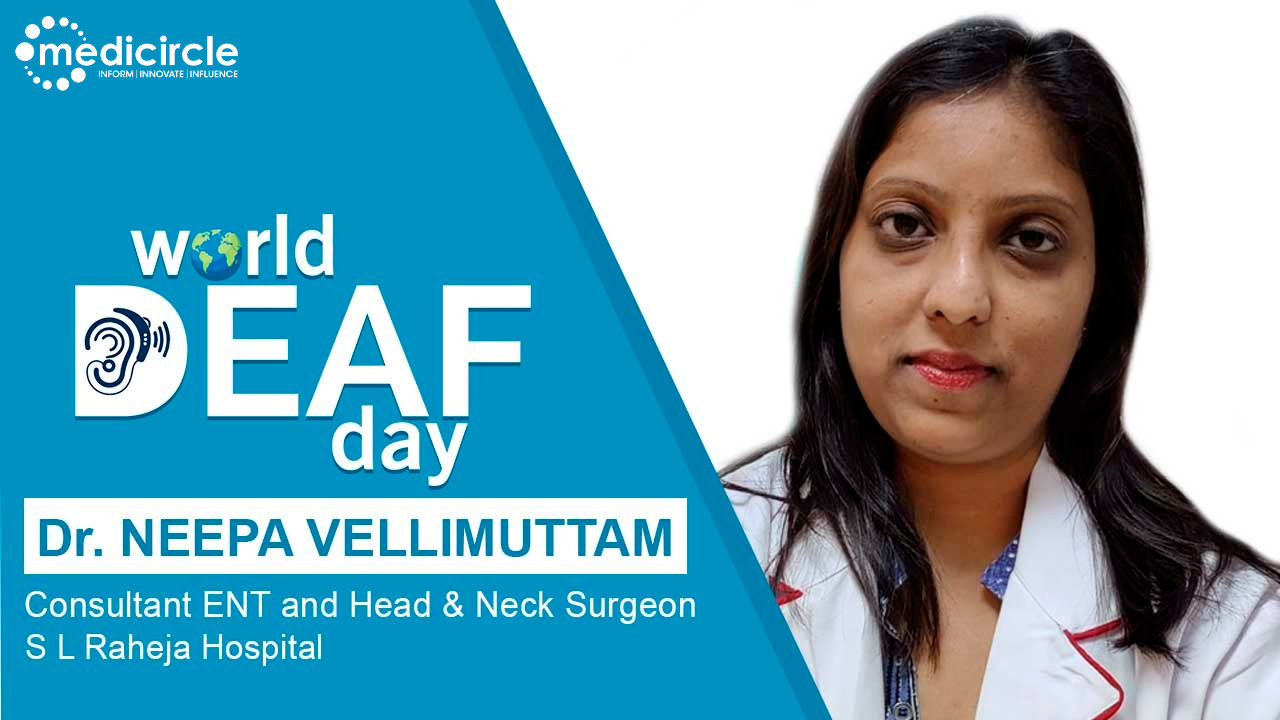According to WHO, there are 360 million persons in the world with disabling hearing loss. Disabling hearing loss is defined as adults (15 years and older): hearing loss greater than 40 decibels (dB) in the better hearing ear; and Children (0 – 14 years of age): hearing loss greater than 30 dB in the better hearing ear.
International Week of the Deaf starts in the last week of September and ends on the last Sunday of the month. This last Sunday is known as World Day of Deaf. This day is celebrated to draw the attention of not only affected people and their family members but also to draw the attention of general people, politicians and development authorities towards the achievements and challenges of the deaf community. We at Medicircle are conducting the World Day of Deaf Awareness Day Series to create awareness on the prevention and control of hearing impairment.
Dr Neepa Vellimuttam is practising as a Consultant ENT and Head & Neck Surgeon at S L Raheja Hospital, Mumbai. She is expertise in Otology, Rhinology, Paediatric ENT, Laryngology, Head and Neck Surgery, and Maxillofacial Surgery. She won the first prize for a paper titled ‘Endoscopic Surgery in Carcinoma of Larynx’ in the Research Meeting held at Bombay Hospital in November 2008.
Causes of Deafness
Dr starts by saying, “Deafness can be caused by a variety of reasons. We have characterised deafness into two categories - one is Congenital and the other is Acquired. Congenital is when children are born deaf. This is due to the non-development of hair cells inside the cochlea or ear organ. This is not working properly hence doesn’t function hearing. Acquired can be caused by a lot of reasons such as ageing, infections, trauma or tumour. right. Deafness can also be classified into two types sensorineural and conductive deafness. Sensorineural deafness is one in which the hearing nerve and the nerve elements are not functioning adequately. And conductive deafness is one in which there are certain conditions of the year, such as infections, which gives rise to some perforation of the eardrum, presence of cholesteatoma in the ear or just presence of simple wax can also reduce the hearing.
The most common factor of deafness is age. Ageing causes degeneration of inner ear structures as time progresses. Other conditions causing hearing loss are chronic ear infections, giving rise to perforation in the eardrum or chronic mastoiditis. Other causes can be used of ototoxic drugs, gentamicin and streptomycin. So when doctors prescribe these medicines they also tell the patients that they might suffer a hearing loss. Even exposure to loud noise can lead to deafness.
There are some occupations where people who work in situations with continuous exposure to loud noise can also face deafness. There are certain hereditary causes, genetic causes, which are rarer causes of deafness. Other reasons such as viral illnesses can cause deafness due to the damage of the hearing nerve, the outer hair cells inside the cochlea, and very rarely, certain brain tumours."
When to consult the doctor?
Dr Vellimuttam explains, “One should consult an ENT specialist whenever you’re facing problems such as ear discharge or chronic ear pain. A doctor should be consulted when you face headaches on one side of the ear or if you are having some infection. If you have an ear infection and the ear infection is treated at the right time, your hearing won’t be affected. However if the infection is left untreated for a long period of time, the hearing can be damaged permanently to a certain extent.
Also, you should meet your ENT specialist as and when you observe that your hearing in one ear is lesser as compared to the other. My suggestion is that whenever you have a slight doubt or a small symptom or problem, then it is better to consult an ENT specialist because there are treatment options for each and every ailment and we can tackle them if the patient comes to us at the right time."
Traditional Remedies for Ear Problems
She says, “There are quite a few traditional remedies. I’m sure all of us have heard from our parents or from our grandparents about garlic oil. Garlic has very good anti-microbial, anti-viral and antifungal properties. So garlic usually helps if you have an external ear infection. Another traditional remedy is to use oil for wax. Oil is a lubricant, so when we put oil in our ear it helps to soften the wax and for self-expulsion.
The other traditional remedy is steam inhalation. When we catch a simple cold our nose gets blocked. Your ears also feel blocked. You feel an echo. So why does that happen? It happens because of the eustachian tube, the tube between the nose and the ear. So when you have too much cold your nose and your sinuses get blocked and the eustachian tube also gets blocked. This gives you the feeling or sensation of blocking and clogging in your ears. So the best way to get rid of this is to take steam. Steam helps open up the passages inside your nose and sinuses. It also helps to prevent infection from further spreading into the ears or any accumulation of fluid into the ears.
If you are experiencing severe ear pain, you can use some hot compresses or hot pads and apply to the ear area to lessen the pain to a certain extent. Apart from the traditional remedies, one should definitely meet an ENT specialist because the cause of your ailment has to be tackled and diagnosed to be treated as soon as possible."
Treatments for Hearing Loss
Dr suggests, “Hearing loss or deafness have a lot of treatment options, depending on the cause and the type of deafness. So if it’s age-related deafness or sensorineural deafness where the nerve is not functioning properly, the treatment we recommend is usually a hearing aid. There are many types of hearing aids and different brands of hearing aids are available in the market. But it’s very important to know that the hearing aid must be customised for each and every patient, you cannot use a hearing aid that is being used by your partner or by somebody else. This is because every patient has a different hearing threshold. And the hearing aid is fine-tuned as per the residual hearing that the patient has.
For conductive deafness, the treatments are offered by treating the primary disease and in certain conditions, surgery is required. Now there is another condition called otosclerosis. It is usually seen in women but even men get affected by this. What happens here is the hearing bones inside our ears get fixed and do not vibrate as they are supposed to. This stops the transmission of the sound waves into the inner ear. So this condition requires a surgery called a stapedectomy, where we replace the fixed bone with a piston, which then does the job.
The treatment of congenital deafness is a cochlear implant. When a child is born deaf, the child should be implanted before the age of seven years. If this is done satisfactorily then there is good development of hearing as well as speech. If the child cannot hear, the child won’t be able to speak. I stress again that this needs to be done before the age of seven years, if you delay it beyond that, especially after 10 years. The child will get no help out of it because the brain has a certain capacity to learn. After the age of 10, the brain will not be able to comprehend or interpret the sound stimulus which is given by the implant.”
(Edited by Priyal Shah)

 Know the reasons behind hearing loss and the ways in which it can be prevented with Dr Neepa Vellimuttam.
Know the reasons behind hearing loss and the ways in which it can be prevented with Dr Neepa Vellimuttam. 








.jpeg)


.jpg)







.jpeg)

.jpg)




.jpg)




.png)


